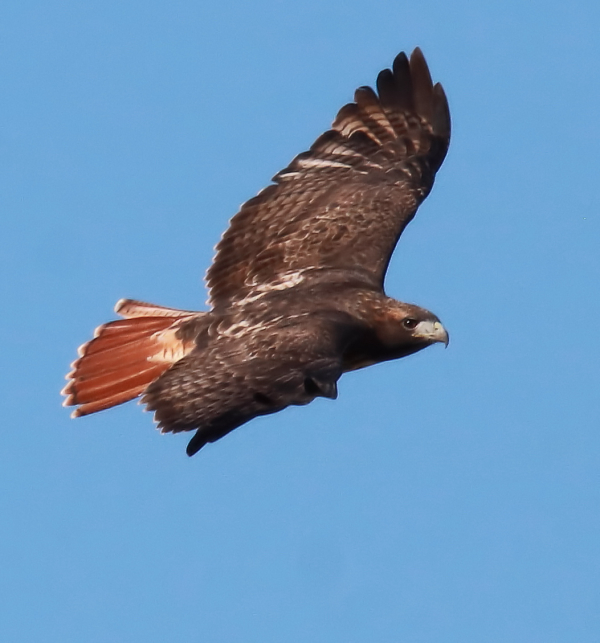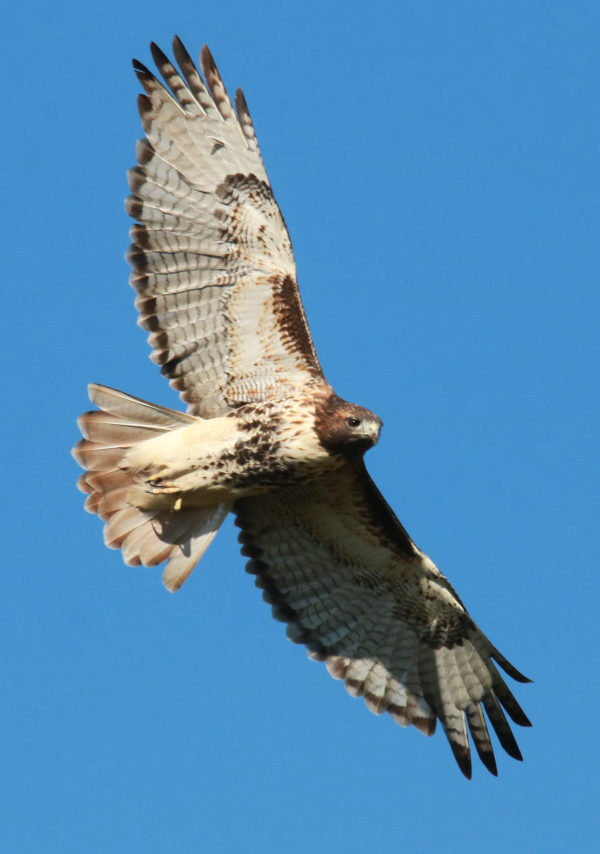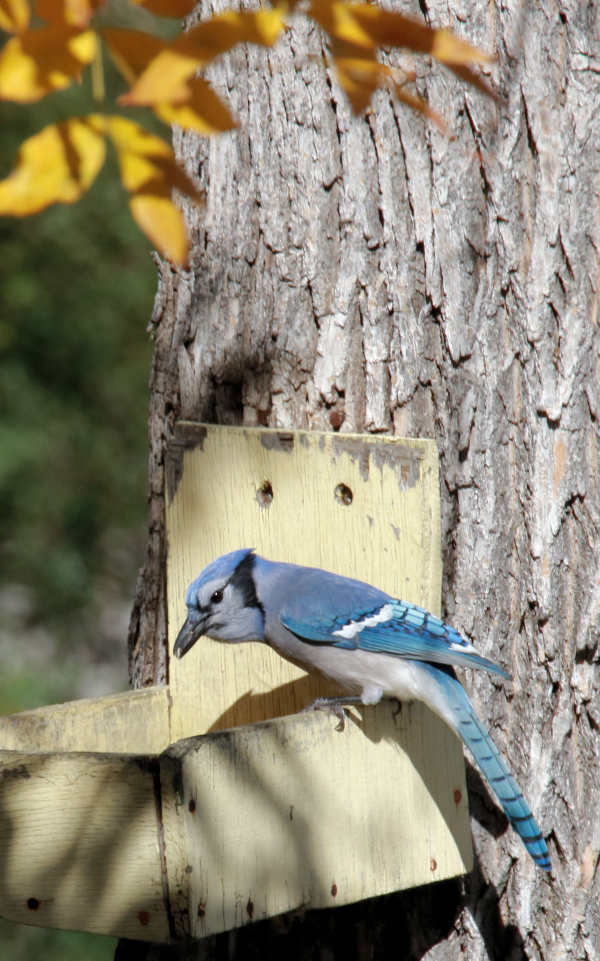
A migrating Red-tailed Hawk that probably originated from the northern forests of Canada shows a very dark-brown backside with a red-orange tail (above). The same soaring hawk shows a belly band and dark accent markings on its underside (below).


The first Blue Jay of fall was surprisingly silent, but filled its mouth and throat with peanuts from a neighbor’s feeder.
|
Rainy, cool, overcast weather plagued the middle and end of last week, but Saturday dawned sunny and clear, and the promise of great birding episodes soared high. Even so, the highlights mostly included similar birds from the previous week, and even some of the same individuals – namely the dark morph Harlan’s Red-tailed Hawk and an adult Krider’s Red-tail that not only was very white- and light-colored, but its tail showed a rather unique pattern in flight, colored mostly white with a light-orange terminal band that stretches across the end of all its tail feathers.
I was glad to have the company of my great friend and cousin Dwight during the weekend outings while he visited from Portland. Dwight enjoys traveling the backroads of his homeland, and I even drove by 2 of our great-grandfathers’ farm sites, along with a great-great grandfather’s land, which made for some interesting family conversations while birding.
Saturday’s late afternoon birding drive included a wealth of scattered Red-tailed Hawks, quite a few Northern Harriers, but little else short of an adult female Belted Kingfisher, a Sharp-tailed Grouse, and an adult Bald Eagle perched atop the highest hill in the area, as it has periodically during the past several weeks. Dwight described the Bald Eagle as majestic with a panoramic view from a local landmark as it turned its head to face the sun. But I’d say Dwight most enjoyed watching the kingfisher’s spunk as it dived several times for prey along the edge of a cattail-lined prairie marsh.
As we were returning home, driving toward the setting sun, just another Red-tailed Hawk landed on a snag ahead of us. We could only see a silhouette as we looked into sun, but as we passed by the raptor, I thought I should verify its color with binoculars, only to see it might be a dark morph hawk. Sure enough, as we positioned between the setting sun and hawk, it was clear this was a “black hawk.” We tried to get a better look, but the dark morph Harlan’s Red-tailed Hawk was mighty wary, so we figured we’d check for it again the following day.
Sunday was another one of those perfect days, complete with fall colors. Returning to the “black hawk” zone that afternoon, we checked a number of Red-tailed Hawks before I was able to ascertain one was the black Red-tail as it flew toward the sun to perch in a bare tree a long distance to the west. We continued to the Lost Road, and sure enough, I was able to show Dwight an opposite “white hawk” and when it took flight, we watched for the indicative white tail with the light-orange terminal band. Yes sir, it was the same adult Krider’s Red-tailed Hawk that I observed the previous Sunday. Likewise, it was not available for photos, but it was interesting to see that these 2 hawks appeared to be occupying the same general area for an extended period during an unhurried migration. I look forward to finding both of these impressive birds again.
Sunday Falcon
After the Krider’s sighting I revealed to Dwight that I was still on the lookout for my first fall Peregrine Falcon, which added a little more of an edge to our search along the Lost Road. Then, as we reached the peak of the Coteau escarpment, I noted a Redtail-looking raptor launch into a low flight far ahead at the base of the steep hill. But when I took a look through binoculars I could this was in fact a big Prairie Falcon, a big female that coursed across the green prairie low to the south. After losing sight of her, we searched in vain to find the falcon again during a couple miles of searching. This was the first Prairie of the season in my home range, although I sighted 3 others considerable miles to the west and northwest during August and September.
As we made the last turn for home I shared with Dwight that I haven’t been seeing pheasants in the area, although I knew there was pretty good nesting production. We only passed about 2 miles before the first rooster pheasant flew into view, 100 yard farther another male Ring-neck crossed the road, and just 2 miles from home a big male strutted with 4 hens roadside. Funny how that works.
Monday’s drive was solo, and it yielded no Harlan’s or Krider’s, but there were many other Red-tailed Hawks, with a few Great Blue Herons, quite a few Great Egrets, scattered Greater Yellow-legs, a bathing Wilson’s Snipe, Killdeer, a long single-file flight of White Pelicans and Double-crested Cormorants, a couple young Black-crowned Night Herons, and another lone Sharp-tailed Grouse, this one with its crest raised and tail erect in display mode. Also, I re-found the female Belted Kingfisher ½ mile from where she was fishing Saturday, but the bigger surprise was sighting a male kingfisher a few miles down the road.
Songbirds Out My Door
BirdCast had predicted a big overnight migration Sunday night and early Monday morning, so I was alert for songbirds Monday morning, and almost immediately I spied a couple Yellow-rumped Warblers and several Dark-eyed Juncos outside my front door. More juncos would follow, but it’s interesting that they weren’t ground-oriented as usual; instead they foraged in the trees like warblers. There were also a few Chipping Sparrows, and the first couple Blue Jays of the season, although it was interesting they weren’t vocal at all.
The sightings inspired me to try to photograph some songbirds among the colorful fall leaves that are so prevalent here now, and I even drove over to Melody’s Grove, which was gorgeously colored in yellow and golden leaves, but there was not a bird in sight. I watched and listened to falling leaves, but returned home to the apparent bird hub of the area that was still filled with lively avian action.
Throughout the week, my suet feeder continued to attract male and female Hairy Woodpeckers, male and female Downy Woodpeckers, and White-breasted Nuthatches; and the leaves continued to change to yellow, gold, orange, and red, dropping leaves daily. Gee, I’d sure like to get some photos of a bird or 2 perched among a bouquet of colorful leaves – now’s the time. Enjoy your week with some inspired birding, especially Saturday during the October Big Day!
Article and photos by Paul Konrad
Share your bird sightings and photographs at editorstbw2@gmail.com